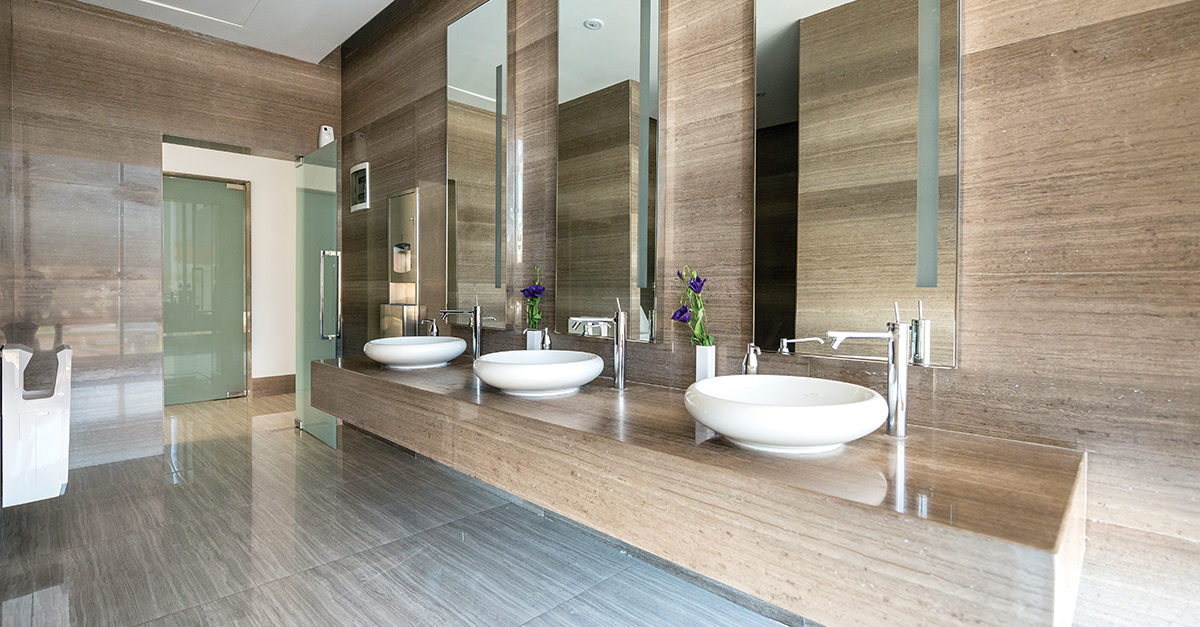Restroom appearance, in many industries, plays a big part in customer perception. For example: Consumers will often avoid a business with a dirty restroom, while a luxurious restroom can have an extremely positive effect on how patrons perceive a building, and even a business.
“The lobby is the first thing, then the elevator, and then the restroom—they’re always key first impressions,” says Alan France, director of sustainability, environmental services at facility management service provider ABM.
Appearance isn’t the only factor. Due to a growing concern about antibiotic-resistant superbugs like Clostridium difficile, also known as C. diff, restroom users are often concerned about coming into contact with germs. As a result, in recent years, buildings have begun to add a number of new, lavish, and often more efficient amenities, which can significantly alter a restroom’s cleaning needs. Industry experts also predict this will impact commercial restrooms in the years to come.
Keep reading to find out what commercial restroom trends are on the horizon—and how they stand to change the methods, training, and tools many building maintenance providers currently use.
Key Cleaning Changes
Commercial building restroom renovations and construction may include a number of new features, ranging from surface materials that require specific cleaning products to automated devices that prevent cleaning crews from having to deal with discarded hand towels. Some of the fastest growing trends include:
Relatively scour-free flooring. For years, laminate countertops and 4-by-4 glazed-tile floors were a common choice in high-volume restrooms; however, grout associated with these products can potentially pose cleaning issues.
“Grout is the enemy,” says Jay Mandelstam, president of Colorado-based Integrated Cleaning Services, the commercial cleaning division of Denver Commercial Property Services. “It’s so porous that it pulls everything in.”
According to Julie Williams, associate IIDA interior designer for architectural, engineering, interiors, and technology design firm Larson and Darby in Rockford, IL, industries ranging from health care to education have responded by designing restrooms with larger 12-by-24-, 18-by-18-, and 24-by-24-inch tile, which eliminates many of the room’s grout lines.
“Some cleaning agents will collect where the floor meets the tile,” she says. “The larger tiles help eliminate that, so you don’t need to worry as much about germs and dirt.”
Mandelstam has also seen office buildings use large concrete slabs, which are often welded at the seams or sealed, as restroom flooring, instead of tiles. “In terms of nightly cleaning, a slab doesn’t necessarily save us time,” Mandelstam says. “Where we’re saving time is in the periodic routine, where we use to have to come back and do a deep scrub on the grout lines.”
High-end surfaces. Countertop materials like stone are also gaining popularity for commercial restrooms. Frequent choices, according to Williams, include quartz, which provides a look that’s close to granite, and a composite solid surface material made from acrylic resins that have natural materials mixed in.
The countertops have nonporous properties, helping them stay cleaner and germ-free longer—one reason, Williams says, many clients are OK with the higher cost. “They can be anywhere from 5 to 15 percent more expensive than the traditional materials, but we see more people making that investment in the forefront because they’re saving on the maintenance side of things,” she says.
Custodial staff may say bleach is the best way to disinfect countertops, and in some cases, Williams says, a diluted solution will suffice. However, many solid-surface countertops come with recommendations for proprietary cleaning agents, which Williams’ clients often see a benefit in using, particularly after building owners and managers discuss product warranties and manufacturer guarantees.
“There might be an initial cost in switching over, but we tell them, ‘If you use something else, and the product isn’t performing, the [chance] of the manufacturer supporting any claims is probably pretty low,’” she says. “It’s really in their best interest.”
Hands-free features. A recent Bradley Corp. handwashing survey found that people go to great lengths to avoid germs in public restrooms. More than half (57 percent) of respondents admitted to operating the toilet flusher with their foot, and 55 percent said they used a paper towel to touch the restroom door.
To help building visitors avoid contact with restroom appliances and other high-touch surfaces, some commercial spaces have added automated soap dispensers, faucets, and other items. Automated roll-based hand towel dispensers that provide just enough paper to dry your hands, for example, are one addition that can help eliminate surplus paper costs—and maintain clean surfaces longer.
“Dispensing a set amount, instead of having someone pull some out and throw away half the ones they didn’t use, can reduce people touching the same things over and over, [potentially picking up germs], and offer a savings,” France says.
Additionally, the dispensers help decrease countertop and floor-discarded paper waste, which should help make cleaning staff’s job a bit easier. However, they don’t always translate into a drastic time reduction. “Unfortunately,” France says, “germs don’t stand out like bright purple objects so we know where they are, so we still have to clean the same surface base.”
Touchless technology cleaning tools. Mandelstam’s company has purchased several touch-free devices that spray non-acid disinfectant cleaner on fixtures, mirrors, and walls in addition to a neutral cleaner on floors. “The devices work well in heavily trafficked restrooms—schools, lockers rooms; we do some spas and health clubs that have steam rooms and showers,” he says.
Touch-free restroom cleaning devices, according to Mandlestam, which start at about US$1,500, can increase efficiency and successfully kill germs. He expects the devices to become more commonplace as the expense gradually comes down, but for now, “the cost,” he says, “is still the biggest thing preventing widespread use.”
Water-conserving amenities. Waterless urinals—which don’t require frequent flushing and therefore reduce water use and expense—have been catching on in recent years, according to American Restroom Association Program Manager Robert Brubaker. “That’s a trend,” he says. “You often see that type of change being implemented [first] by municipalities in public restrooms.”
The urinals—according to Linda Pace, president and CEO of restroom product and service provider Workplace Essentials—have been around for roughly 20 years; but recently, marked product changes that help reduce odor issues have made them a more frequent choice.
If your building has waterless urinals, some cleaning stipulations apply. Using strong chemicals on waterless systems that pass urine through a sealant barrier to reduce odor will break down the scent-stopping barrier. To prevent erosion and odor issues, daily cleaning should involve a nonchemical spray, followed by a water rinse, according to Pace. “You need to make sure the cleaner uses a natural product, which may mean educating the cleaning staff to ensure proper maintenance.”
Cleaning tools that cut water use. New and improved cleaning aids are also helping service providers conserve water. Mandelstam, for example, has switched from using traditional cotton-head mops to microfiber systems. “We use much less water and actually remove germs better because we’re not dipping that mop back into a bucket and contaminating the solution,” he says. “We’re no longer sloshing 35-quart buckets through buildings; we’re just dampening the microfiber cloth.”
Microfiber cleaning tools have also helped Integrated Cleaning Services enhance restroom safety. “Using less water reduces the chance of [slips] and falls in bathrooms [because] it reduces drying times,” Mandelstam says.
Devices that decrease paper use (and mess). Paper products, Pace says, may not ever completely go away; they’re a necessary component in industries like food manufacturing and restaurant kitchens.
However, she feels hand dryer acceptance is markedly on the rise, thanks in part to the introduction of more high-efficiency, low-energy commercial use dryers, which can also reduce a building’s supply expenses. “The cost savings can be massive for people who convert from paper to automatic hand dryers,” Pace says.
Reconfigured restrooms. Commercial spaces with singular women’s and men’s restrooms, according to Brubaker, may be able to speed up the cleaning process by converting each space to a unisex restroom. Whether it’s a large office building with singular restrooms in certain areas or a small business, such as a coffee shop, the conversion cost is generally low because it just involves replacing restroom signs—one reason Brubaker anticipates genderless restrooms will become more of a trend in the next few years.
“Cleaners now have the ability to [occupy] a restroom in need of cleaning, and still have the other restroom available,” he says.
The End Result
Like so many of the water conservation, floor design, and other commercial restroom advancements from the past few years—in addition to the ones expected in the future—the change to individual unisex restrooms is centered on a fairly basic goal: Creating a cleaner bathroom space. And ultimately, it should have the same effect: Providing a positive experience for the end user.
“We think it’s going to catch on because it’s a plus for businesses,” Brubaker says. “And it really provides a better customer experience.”



